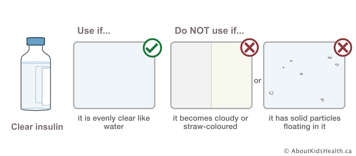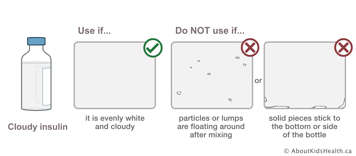If your child requires insulin you will need purchase it at a pharmacy. It is important to know how to properly store insulin and when it is unsafe to use.
Where is insulin sold?
Insulin is sold in any pharmacy. In most places, some types of insulin are available without a prescription. Each vial or cartridge has an expiry date (usually one to two years after the purchase date). You should throw out the insulin after it has expired.
Insulin costs vary depending on type. The cost of insulin is covered by some provincial government healthcare plans in Canada. Most insurance companies need a prescription to refund the cost.
How should insulin be stored?
Insulin can be kept safely in the refrigerator (2 to 8 degrees Celsius) until its expiry date. After it has been opened, it can be stored in the refrigerator or at room temperature for a month. When starting a new bottle, write the date on it so you can tell how long it has been since you opened the bottle.
Insulin is a very stable substance that does not “go bad” easily. However, insulin can be damaged if it freezes or gets extremely hot. When in doubt, throw out the insulin and use a new vial or cartridge.
As a general rule, you should avoid shaking the bottle up and down or the insulin will become frothy and hard to measure accurately.
When not to use insulin
When not to use rapid- or long-acting insulin
Do
not use “clear” insulin (rapid- and long-acting insulins) such as Glulisine (Apidra), Lispro (Humalog), Aspart (NovoRapid), Determir (Levemir) or Glargine (Lantus) if:
- it becomes “cloudy” or straw-coloured
- it has solid particles floating in it.

When not to use intermediate-acting insulin
It is natural for the white substance in cloudy (intermediate-acting ) insulin to settle to the bottom of the bottle over a period of time. This should mix easily into the solution.
Do not use “cloudy” intermediate-acting insulin (such as Humulin-N or Novolin-NPH) if:
- particles or lumps are floating around after mixing
- solid pieces stick to the bottom or sides of the bottle.

To be safe, if the insulin is exposed to freezing or very hot temperatures, throw out the bottle.
If a child is hiking, camping, or travelling long distances, protect bottles from breaking and protect insulin from temperature extremes by wrapping bottles individually. Then place them in a small thermal container to avoid extreme temperature variations. Always keep a spare bottle of insulin on hand in case one gets broken. For children using two kinds of insulin, keep a spare bottle of each type.